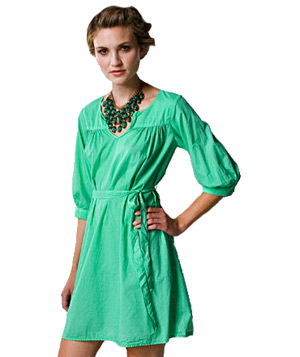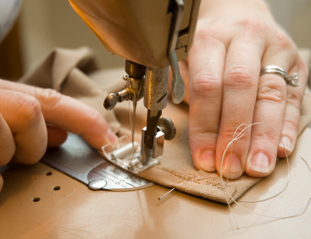As general public is becoming acutely aware of many severe environmental issues associated with commercial production of clothing, more people are starting to look for Eco-friendly fashion options. As a result of this rising demand, handmade clothing is leading the way as a green alternative to commercial clothing. Handmade clothing can now be found in many local clothing boutiques, as well as online. Many fiber and textile artists, fashion designers, and small clothing labels are offering a wide variety of handmade clothing for women, men and children. While you may find that some handmade clothing is still more expensive than the kind of bargains you can get at Target or the Gap, it is a price worth paying, considering that you can look fabulous while making a positive contribution towards preserving our Earth.
Benefits to the Environment
The number one reason to switch to handmade clothing is that it helps reduce global warming, and does not waste and pollute precious natural resources like water. Different handmade clothing labels will use different types of environmentally friendly practices for their green clothing products.
Manufacturing Process
Since commercial clothing is mass produced in factories, it wastes enormous amounts of energy and produces a lot of green house gas emissions and toxic wastes, all of which are dumped into the air, ground and water. Handmade clothing companies avoid this process all together, by hand making the piece from start to finish.
Coloring
To achieve all the bright colors that are so attractive, commercial clothing production involves the use of highly toxic industrial dyes. These dyes are made of one of the most polluting, harmful chemicals, which are dumped into the rivers, lakes and other bodies of water during the manufacturing process. This renders the water undrinkable and harmful to health. On the contrary, handmade clothing is made either with natural dyes produced from plant extracts, or a different type of commercial grade dyes that are not as toxic and harmful to the environment.
Fabrics
Many handmade clothing companies will use fabrics that have been produced in Eco-friendly ways, such as cotton and silk that has been hand-loomed. The processing of natural fibers such as cotton into fabric is one of the most polluting industrial processes that wastes a lot of water, requires a lot of energy, and utilizes highly toxic chemicals. Production of synthetic fibers such as polyester is even more harmful to the environment. Many designers make their contribution to the environment by avoiding this process all together, and making upcycled handmade clothing. This means that they recycle old clothing and give it a brand new life, helping reduce both the amount of new clothing that is being produced as well as the amount of waste from its disposal.
Limited Quantities
No matter how you slice it, production of any type of clothing takes a toll on the environment. Some Eco-conscious handmade clothing companies like Sol Maleu Batik mitigate this effect by producing clothing in very small quantities. Handmade clothing is intended to be worn for a long period of time, instead of prompting consumers to constantly buy more clothing, thus fueling the demand for mass production.
Labels and Packaging
Many handmade clothing companies ensure that their clothing is green all the way. The clothing tags, labels and packaging materials are often also handmade from recycled fabrics and papers, helping reduce waste and pollution.
Personal Benefits
Exclusive style and design
If you have, or would like to develop a distinct personal style, handmade clothing allows you a wide range of opportunities to do just that. Many handmade pieces are either one-of a kind, or produced in small, limited edition quantities. Long gone are the days when handmade clothing was the equivalent of hippie clothing. While hippie style is one of the trends in handmade fashion, there are plenty of other modern and classical styles that would satisfy a wide variety of tastes. Handmade clothing also does not have to look like it was made by your grandmother, unless that is something you like. Many handmade clothing brands offer high quality of craftsmanship that is indistinguishable from commercial manufacturing.
Durable and long lasting
Handmade clothing is made out of high quality materials, with a high level of personal attention, and quality control from the maker. It is made to last for years, rather than to be discarded after one or two seasons.
Health Benefits
A lot of handmade clothing is made out of premium textiles such organic cotton, Eco-friendly modal fabrics and silk. These fabrics will not only feel amazing to your skin, but will also be none-toxic and none-allergenic. Unlike commercial synthetic fabrics, these natural fabrics are also more breathable, and do not trap heat and moisture. This means that you will feel comfortable both in hot and cool temperatures, and sweat less.
One of the most attractive benefits of handmade clothing is that it can be custom made. Depending on the type of clothing and the company that makes it, pieces can be tailored to your measurements, you can choose your own colors and patterns, add writing, and do a variety of other things to make a piece truly your own. Moreover, handmade clothing and accessories such as scarves make excellent gifts for people who would like something special and more personal.
Why does handmade clothing cost more than many commercial brands?
Handmade clothing is more expensive primarily due to the labor intensive nature of the process. Taking automated processes out of the equation of clothing production, means that everything from design, to coloring to sawing is made by human hands. Therefore this process becomes much more difficult and time consuming. Also, many handmade, Eco-friendly clothing brands choose to use fabrics produced in environmentally safe ways, which also cost more than commercial fabrics. If they choose to outsource part of their production, they pay higher prices for labor to make sure that there are no environmental, or human rights violations in the process. Finally, some handmade clothing, such as wearable art pieces, may cost more because of its unique and exclusive design.
About the Author
Aleksandr Biyevetskiy is an avid proponent of green building technology for residential and commercial construction, and a big fan of sensible sustainability for businesses, government, and society. Alex also maintains a personal blog, in which he covers a variety of concurrent/relevant topics at www.Tampile.com/Blog.
Connect with Alex on Google Plus:



